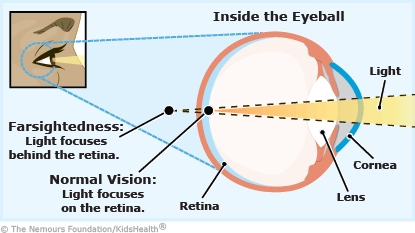Kids with farsightedness (hyperopia) can see things better when they're far away rather than close up.
In normal vision, light that reflects off an object enters the eye through the cornea and lens and focuses on the retina, at the back of the eye. The brain "sees" a clear image. In farsightedness, the light focuses behind the retina instead of directly on it. The brain "sees" a blurry image.
Many kids are farsighted. Often, farsightedness gets better on its own as kids get older. If it doesn't, the eye doctor (an optometrist or ophthalmologist) will prescribe glasses or contact lenses.


Follow your health care provider's advice for:
If your child needs eyeglasses or contact lenses, follow your health care provider's advice for:
Other tips:
If your health care provider prescribes eyeglasses or contact lenses for your child:

Your child:
Call your health care provider if your child wears contacts and:

What are the signs of farsightedness? Kids with farsightedness have blurry vision when looking at things that are close. They may also squint, rub their eyes, and not be interested in looking at books and reading.
Can eye surgery help with farsightedness? Eye surgery can help with farsightedness but only after a person's eyes are done growing. For most people, this is when they're 18–21 years old. The surgery, called laser refractive surgery, is done by ophthalmologists who use lasers to change the shape of the cornea to correct the farsightedness.